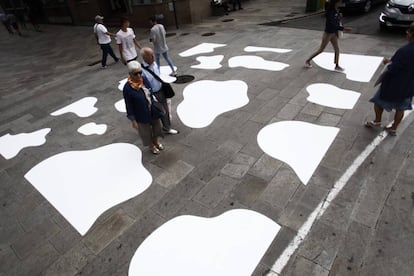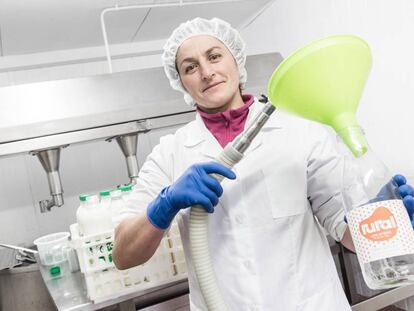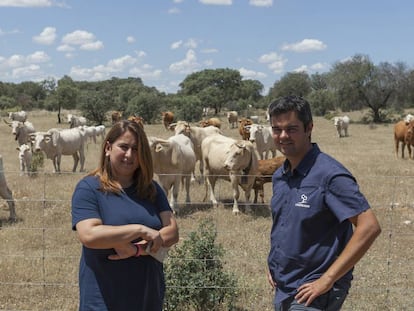Dear dairy: Galicia ditches zebras for cows at a city crosswalk
A Coruña has opted for spots rather than stripes at a pedestrian crossing, in recognition of the importance of the animal for the region’s farming

The Spanish region of Galicia, located in the northwest of the country, is a land of cows. So much so, that in some municipalities, it is the human race that could be considered an endangered species. Around a million of the animals – one for every 2.7 inhabitants – live there, while more than 8,400 families run dairies that produce more than half of all the milk consumed in Spain.
Given their importance in the region, cows are a “symbol of peace,” as Galician poet Alfonso Daniel Rodríguez Castelao once said
Given their importance in the region, then, cows are a “symbol of peace,” as the Galician poet, writer and painter Alfonso Daniel Rodríguez Castelao once said.
In line with this thinking, the city of A Coruña has just unveiled its first “cow-walk,” a crosswalk – or zebra crossing as they are known in some parts of the English-speaking world – that ditches the traditional stripy pattern for the distinctive white patches of a Friesian cow’s hide.
The initiative will be a way of reminding the city-dwellers of Galicia that the green pastures that are home to the region’s cows are just a stone’s throw away.
The location for the cow-walk was proposed by City Hall, but the idea was dreamed up 54 kilometers to the south, in the Casa Grande de Xanceda, a dairy located in Mesía, A Coruña where 380 cows are reared for their milk, which is used to make ecological yogurt.
Zebras do not represent Galicians, but cows are a part of our very essence
Jessica Ray, head of marketing at dairy Casa Grande de Xanceda
While the city slept, the dairy was charged with painting on the distinctive spots of a Friesian cow, which will, from now on, indicate where humans have priority. Friesians are not a native breed, but they are in the majority in the region. “Zebras do not represent Galicians, but cows are a part of our very essence,” says Jessica Ray, the head of marketing at the Casa Grande de Xanceda. “We don’t want this cow-walk to be a mere anecdote, but rather for the idea to be exported to the streets of other cities and towns in Galicia. This first one is merely the prototype.”
To coincide with the unveiling of the cow-walk, the company organized an information day “to bring the rural world to the city,” and along the way explain the true value of a liter of milk. Given that the farm prides itself on rearing “happy cows,” rather than bringing a live animal to the center of the city, they came with a fake, life-sized animal, loaded with milk. Before members of the public got a chance to actually milk the stand-in cow, they could put on virtual reality glasses that would teleport them to a meadow.
Before members of the public got a chance to milk the stand-in cow, they could put on virtual reality glasses that would teleport them to a meadow
“In this community, the cow is a symbol of prosperity,” explains Rey. “Despite the constant crises in the sector due to the fluctuation in the price of milk – which has fallen constantly in the last six months, causing losses of €20 million – where there are cows, there is always an opportunity.”
The sector, the company says, “is a source of employment and development,” and without it, the hemorrhage in population that rural parts of Galicia are suffering would be even more acute. “There are more than enough reasons to celebrate the cow as an icon of Galicia,” it argues, “giving it the importance that it deserves in our culture and society.”
English version by Simon Hunter.
Tu suscripción se está usando en otro dispositivo
¿Quieres añadir otro usuario a tu suscripción?
Si continúas leyendo en este dispositivo, no se podrá leer en el otro.
FlechaTu suscripción se está usando en otro dispositivo y solo puedes acceder a EL PAÍS desde un dispositivo a la vez.
Si quieres compartir tu cuenta, cambia tu suscripción a la modalidad Premium, así podrás añadir otro usuario. Cada uno accederá con su propia cuenta de email, lo que os permitirá personalizar vuestra experiencia en EL PAÍS.
¿Tienes una suscripción de empresa? Accede aquí para contratar más cuentas.
En el caso de no saber quién está usando tu cuenta, te recomendamos cambiar tu contraseña aquí.
Si decides continuar compartiendo tu cuenta, este mensaje se mostrará en tu dispositivo y en el de la otra persona que está usando tu cuenta de forma indefinida, afectando a tu experiencia de lectura. Puedes consultar aquí los términos y condiciones de la suscripción digital.
More information

Meet the women behind Galicia’s first brand of “feminist” milk

Meet Spain’s unlikely 21st-century shepherds
Archived In
Últimas noticias
Most viewed
- Oona Chaplin: ‘I told James Cameron that I was living in a treehouse and starting a permaculture project with a friend’
- Sinaloa Cartel war is taking its toll on Los Chapitos
- Reinhard Genzel, Nobel laureate in physics: ‘One-minute videos will never give you the truth’
- Why the price of coffee has skyrocketed: from Brazilian plantations to specialty coffee houses
- Silver prices are going crazy: This is what’s fueling the rally








































